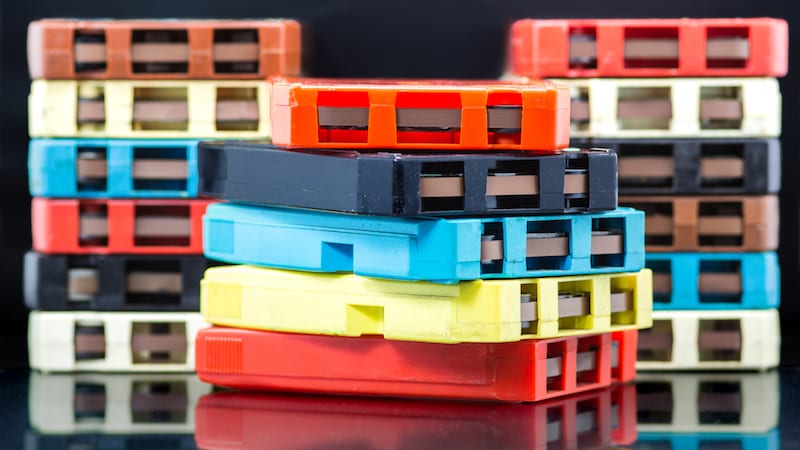Several years ago, I reconnected with the much-maligned music format of the 8-track tape. My 1978 Camaro came with an 8-track tape player, and I ran Boston, Led Zeppelin, Elvis Costello, and other assorted jams through my Jensen speakers until some of those tapes wore out. Perhaps it was the nostalgia of those days that, on a lark, led me to purchase a portable player and dig up some old tapes. Holding those tapes in my hand again was like an exciting trip in a time machine.
One Sunday afternoon, I headed up to school to catch up on some grading and lesson plans. On the way out the door, I grabbed my 8-track player and a few tapes. Usually, I listened to Pandora at my desk through my computer, not today. That Sunday it was Fleetwood Mac, Styx, and Bob Seger. When I was finished, I left the player on the file cabinet behind my desk; I’d take it home later.
When my students entered the classroom Monday morning, none were the wiser that they were listening to some serious 1970s solid-state, audio technology. When the bell rang, they settled into the class routine and I took roll. Just before starting my lesson, I yanked the 8-track out of the player accompanied by the resounding thwack of cartridge exiting the deck and the slap of the tape door. Heads swiveled. And then it started.
“What’s that?” several students asked in unison.
Me: “It’s an 8-track tape player.”
Student: “What’s that?”
Me: “It plays music.”
Student: “Is it new?”
Me: “Hardly.”
Student: “What are you holding in your hand?”
Me: “It’s a tape. An album. This one is David Bowie.”
Student: “There are songs on that thing? How many?”
Me: “I’m not sure, ten or so. Let me look on the back. Six. This one has six.”
Student: “Six! That’s all? It’s so big. Can I see it?”
And so started my students’ fascination with 8-track tapes. Never had I brought to my class any other type of electrical device or piece of technology that so captured their attention. Ever.
In a world of MP3 players and streaming music, the 8-track tape was the literary equivalent of a stone tablet and chisel. But several of my students recognized my music, thanks to their parents, and that connection seemed to drive their curiosity. In a compromise, I decided we could talk more about 8-tracks during the last five minutes of class. So began “8-track University”, which we would have at the end of each period.
Since I dug 8-tracks, and the students could see I dug 8-tracks, they seemed to catch my fever for them. First, we created a historic timeline of music formats showing vinyl, 8-tracks, cassettes, CD’s, MP3s, and streaming music. (Today you could add the reemergence of vinyl records to the timeline.)
Later, I had my students draw a picture of what they thought an 8-track tape looked like on the inside. My only clues were that you couldn’t rewind an 8-track tape, and the tape would play forever, or until you pulled it from the player. “Why is that?” they asked. They’d find out when I opened one up. (An 8-track’s tape is spooled like a reel of film that actually unwinds and plays from the center, not the outside of the spool. That’s why you could fast forward an 8-track, but not rewind one.) For a writing assignment, they had to explain how that worked and needed to include a labeled diagram.
Each day, my class started with a little music, 8-track style. I would pick a student to pull the tape from the player when it was time to start our lesson. Kids were always surprised how much effort it took to yank the tape from the machine. Usually, they’d admire whatever tape I was playing for a few seconds before putting it on the ever-growing stacks of tapes I was bringing from home. Class favorites? The Saturday Night Fever Soundtrack, Journey’s Escape, and The Cars.
The questions kept coming. “Why is it called an 8-track if there are only 4 tracks of music on the tape?” I explained that the tapes were recorded in stereo, meaning the tape had two tracks, one for the left speaker and one for the right, for each of the four tracks. Four times two is eight.
“Why does a song sometimes switch tracks right in the middle of the song? That’s dumb.” Well, I would tell them, if you have, say, thirty-nine minutes of music and you must divide the songs as evenly as you can over four tracks, sometimes the time doesn’t divide out evenly. A math teacher could easily do a lesson on the best way to organize and distribute the different songs on an album over the four tracks of an 8-track tape to avoid long periods of silence on the end of a track, or a song getting split over two tracks. It’s wasn’t always an easy thing for record companies to do. Obviously.
Before long, students were bringing 8-tracks to class. They were always excited to show me what they had found. And after I showed them how to inspect an old tape, we’d give it a try. When it would play, their faces would light up. Eventually, I’d let a few students come to class during lunch to have a little 8-track party. I called it PBJ Lunch. People Be Jamming.
My 8-track tape player gave me a few ideas for some nice lessons. And the kids and I shared a passion for learning that sometimes, quite frankly, isn’t always so easy to find. A few of the kids even said that they wanted to get a player for themselves. That was particularly groovy—I mean, cool. Sometimes all it takes is a little mutual excitement to uncover new pathways to learning some of the same old skills. And usually it happens by accident. That’s what makes teaching so amazing.
